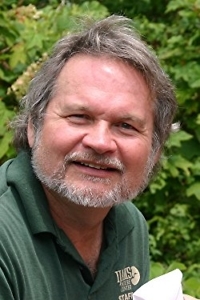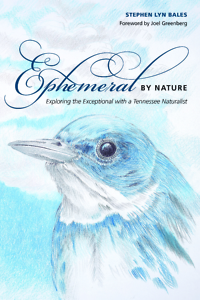Of Ghost Plants and Whooping Cranes
Naturalist Stephen Lyn Bales considers a dozen exceptional species in Ephemeral by Nature
These are difficult days for nature lovers. Pollution, habitat destruction, the decline of countless species, climate change—anyone who takes an interest in the condition of planet Earth had better be prepared for bad news. This state of affairs should make someone like Stephen Lyn Bales, senior naturalist at Ijams Nature Center in Knoxville, more than a bit gloomy. But his collection of essays, Ephemeral by Nature, shows him to be, if not exactly optimistic, at least deeply philosophical about the fate of life as we know it. He makes a convincing case for joy and curiosity despite—or perhaps because of—the transience of all living things.
 Each of the twelve pieces in the collection focuses on a specific plant or animal Bales deems “exceptional.” They’re not all rare, though many of them are either scarce or on the way to becoming so. Some of his subjects, like the ruby-throated hummingbird and the monarch butterfly, are familiar and widely written about. Others, including the ghost plant (aka Indian pipe) and freshwater jellyfish, are fairly obscure. Showing the classic naturalist’s soft spot for unloved life forms, he devotes one essay to the massively destructive southern pine beetle. What all of them have in common is at least a minor connection to Tennessee and a good back-story—or, in some cases, several good back-stories.
Each of the twelve pieces in the collection focuses on a specific plant or animal Bales deems “exceptional.” They’re not all rare, though many of them are either scarce or on the way to becoming so. Some of his subjects, like the ruby-throated hummingbird and the monarch butterfly, are familiar and widely written about. Others, including the ghost plant (aka Indian pipe) and freshwater jellyfish, are fairly obscure. Showing the classic naturalist’s soft spot for unloved life forms, he devotes one essay to the massively destructive southern pine beetle. What all of them have in common is at least a minor connection to Tennessee and a good back-story—or, in some cases, several good back-stories.
Bales’s typical approach is to weave together scientific facts, history, and folklore, and accent it all with a relevant personal encounter or experience. For instance, his essay on whooping cranes—a species that is “a downy feather away from disappearing altogether”—combines a discussion of the birdlike qualities of dinosaurs with an account of the collective efforts, beginning in the 1950s, to save the “whoopers” from imminent extinction. These efforts ultimately led to the famous crane migrations guided by ultra-light aircraft, which Bales witnessed in 2001, when a group of the birds and their human leaders made an overnight stop at the Hiwassee Wildlife Refuge. Bales and a companion, thrilled with the opportunity to “see history in the making,” left Knoxville at 4:00 a.m. to get a glimpse of the early-morning departure:
As daylight began to seep into the valley, a small flock of noisy sandhill cranes flew in and a northern harrier hovered briefly over the field in front of us. The people who had gathered to see the cranes hopped back and forth from left foot to right, partly to keep warm and partly because it was hard to contain the nervous energy that percolated through their systems.
That sense of excitement about the natural world is clearly what draws Bales, like most naturalists, to his vocation, and these essays are likely to inspire a touch of the same eager curiosity in his readers. The collection is, as you might expect, filled with the kind of “Gosh, I had no idea” facts that are a nature writer’s stock-in-trade. Did you know that the oldest, most primitive panda yet found in the fossil record lived in East Tennessee? Or that the imperiled whooping crane was, in fact, always rare, and there were probably no more than two thousand of the birds when Europeans first arrived in North America?
 I didn’t until I read this book, and there’s a certain pure-hearted happiness in having those new bits of knowledge in my possession. Learning that owls have asymmetrical ears (the better to locate the source of prey sounds) or that beetles make up twenty percent of the earth’s species won’t change anyone’s life or even necessarily enhance a person’s love of nature, but knowledge does have a way of fostering wonder, which in turn leads to a deeper sense of the value of living things, even those that might at first glance seem insignificant.
I didn’t until I read this book, and there’s a certain pure-hearted happiness in having those new bits of knowledge in my possession. Learning that owls have asymmetrical ears (the better to locate the source of prey sounds) or that beetles make up twenty percent of the earth’s species won’t change anyone’s life or even necessarily enhance a person’s love of nature, but knowledge does have a way of fostering wonder, which in turn leads to a deeper sense of the value of living things, even those that might at first glance seem insignificant.
Which brings us back to all the bad news for nature lovers. Bales does not shy away from telling the sad stories. His account of the ongoing decline of the lovely cerulean warbler is particularly poignant. But sorrow does not seem to taint the pleasure he takes in the kaleidoscope of living beings, and it’s refreshing to encounter writing about twenty-first-century Earth that is both honest and joyful. “Species come and go, ephemeral all,” he writes in the book’s afterword, “and should we ultimately devastate our planet rendering it uninhabitable for humans, nature will simply reboot, and Nietzsche’s eternal recurrence will come into play.” Coming from another writer, those words might seem fatalistic, but received in the context of Bales’s own curiosity and delight in the natural world, they are comforting, even hopeful.

Maria Browning is a fifth-generation Tennessean who grew up in Erin and Nashville. A graduate of Mount Holyoke College, she has attended the Clothesline School of Writing in Chicago, the Moss Workshop with Richard Bausch at the University of Memphis, and the Sewanee Writers’ Conference. She lives in White Bluff.


